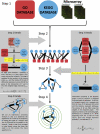Network-based prediction for sources of transcriptional dysregulation using latent pathway identification analysis
- PMID: 21788508
- PMCID: PMC3156179
- DOI: 10.1073/pnas.1100891108
Network-based prediction for sources of transcriptional dysregulation using latent pathway identification analysis
Abstract
Understanding the systemic biological pathways and the key cellular mechanisms that dictate disease states, drug response, and altered cellular function poses a significant challenge. Although high-throughput measurement techniques, such as transcriptional profiling, give some insight into the altered state of a cell, they fall far short of providing by themselves a complete picture. Some improvement can be made by using enrichment-based methods to, for example, organize biological data of this sort into collections of dysregulated pathways. However, such methods arguably are still limited to primarily a transcriptional view of the cell. Augmenting these methods still further with networks and additional -omics data has been found to yield pathways that play more fundamental roles. We propose a previously undescribed method for identification of such pathways that takes a more direct approach to the problem than any published to date. Our method, called latent pathway identification analysis (LPIA), looks for statistically significant evidence of dysregulation in a network of pathways constructed in a manner that implicitly links pathways through their common function in the cell. We describe the LPIA methodology and illustrate its effectiveness through analysis of data on (i) metastatic cancer progression, (ii) drug treatment in human lung carcinoma cells, and (iii) diagnosis of type 2 diabetes. With these analyses, we show that LPIA can successfully identify pathways whose perturbations have latent influences on the transcriptionally altered genes.
Conflict of interest statement
The authors declare no conflict of interest.
Figures


References
-
- Ideker T, Ozier O, Schwikowski B, Siegel AF. Discovering regulatory and signalling circuits in molecular interaction networks. Bioinformatics. 2002;18(Suppl 1):S233–S240. - PubMed
MeSH terms
Substances
Associated data
- Actions
Grants and funding
LinkOut - more resources
Full Text Sources
Molecular Biology Databases

